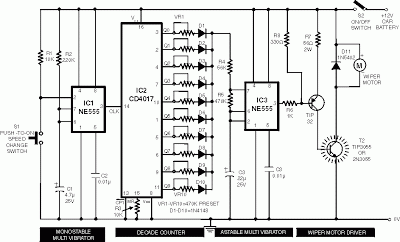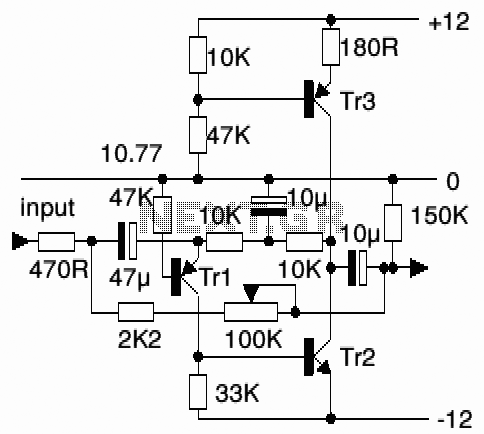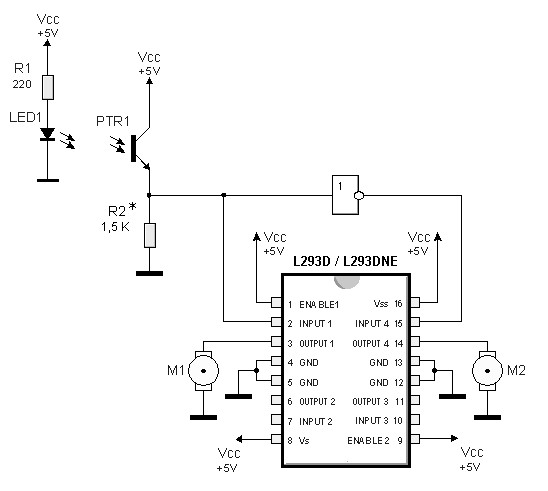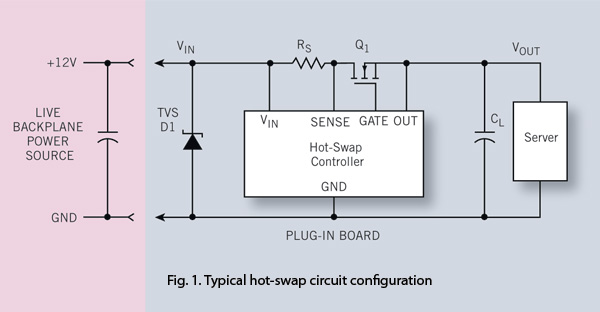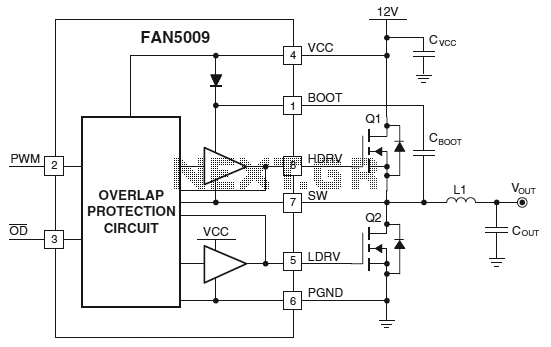
Neuromorphic Silicon Neuron Circuits
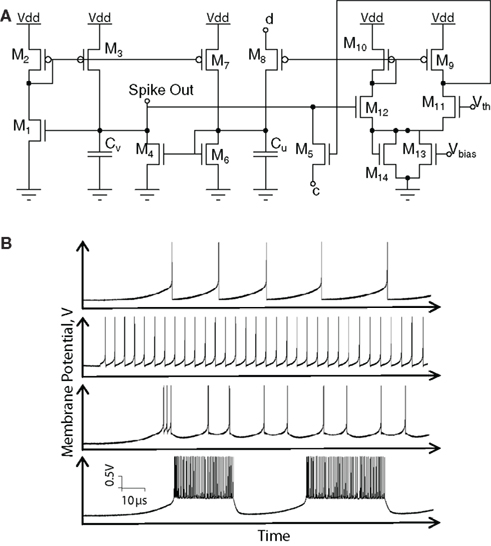
Hardware implementations of spiking neurons are highly beneficial for various applications, including high-speed modeling of large-scale neural systems, real-time operating systems, and bidirectional brain-machine interfaces. The specific circuit solutions for silicon neurons are dictated by the requirements of each application. This paper outlines the most common building blocks and techniques utilized to construct these circuits, presenting an overview of a diverse range of neuromorphic silicon neurons that embody different computational models. These models range from biophysically realistic and conductance-based Hodgkin-Huxley models to two-dimensional generalized adaptive integrate-and-fire models. The paper compares the various design methodologies employed in each silicon neuron design and showcases their features through experimental results obtained from a broad spectrum of fabricated VLSI chips. Spike-based neuron models have gained popularity for exploring the significance of spike-timing in computational neuroscience and for developing event-driven computing systems in neuromorphic engineering. Several spike-based neural network simulators have been created in this context, with significant research focused on software tools and strategies for simulating spiking neural networks. Although digital tools and simulators are practical for analyzing the quantitative behavior of neural networks, they fall short for real-time applications and detailed large-scale simulations of neural systems. Current supercomputing systems cannot achieve real-time performance in simulations that require a balance between accommodating multiple cortical areas and maintaining distinct cellular properties. Custom digital systems that leverage parallel graphical processing units (GPUs) or field-programmable gate arrays (FPGAs) may eventually provide such capabilities, but it remains uncertain whether these systems can match the density, energy efficiency, and resilience of neurons and synapses modeled in the central nervous system. The understanding that the brain operates on analog principles of neural computation, which differ fundamentally from digital principles in traditional computing, has spurred investigations in neuromorphic engineering. Silicon neurons (SiNs) are hybrid analog/digital very large-scale integration (VLSI) circuits that replicate the electrophysiological behavior of real neurons and their conductances. Hardware emulations of neural systems using SiNs function in real-time, with network speed being independent of the number of neurons or their coupling. SiNs provide a platform for directly emulating neuronal networks in hardware, as opposed to merely simulating them on general-purpose computers. They are significantly more energy-efficient than simulations on general-purpose computers, making them suitable for real-time large-scale neural emulations. However, SiN circuits offer only a qualitative approximation of the exact performance of digitally simulated neurons, rendering them less ideal for detailed quantitative studies. The primary advantage of SiN circuits lies in their capability to investigate the real-time interaction of the system with its environment.
The design of silicon neurons (SiNs) encompasses a variety of components and techniques that enable the emulation of biological neural behavior. Key building blocks include transistors configured to mimic the ionic currents that flow through neuronal membranes, resistors to model synaptic connections, and capacitors that emulate the membrane capacitance. These components are integrated into a very large-scale integration (VLSI) architecture that allows for efficient scaling and parallel processing.
In practice, the implementation of SiNs often involves the use of analog signal processing techniques combined with digital control systems. This hybrid approach allows for the precise tuning of parameters such as firing thresholds, adaptation rates, and synaptic weights, which are crucial for the accurate representation of various neural models. The use of feedback loops in these circuits facilitates the dynamic adjustment of neuron behavior in response to input stimuli, mimicking the adaptive nature of biological systems.
Experimental validation of SiN designs typically involves measuring output spike trains in response to various input patterns, allowing for the assessment of the emulation's fidelity to biological neurons. Techniques such as spike-timing dependent plasticity (STDP) can be implemented within these circuits to further enhance their learning capabilities, providing insights into the mechanisms of synaptic plasticity observed in living neural networks.
As research continues to advance in the field of neuromorphic engineering, the development of more sophisticated SiN architectures is expected to enhance the performance and applicability of these systems across a range of domains, including robotics, cognitive computing, and neuroprosthetics. The ongoing exploration of the analog-digital interplay in SiNs will likely yield novel insights into both artificial and biological neural processing, paving the way for the next generation of intelligent systems.Hardware implementations of spiking neurons can be extremely useful for a large variety of applications, ranging from high-speed modeling of large-scale neural systems to real-time behaving systems, to bidirectional brain machine interfaces. The specific circuit solutions used to implement silicon neurons depend on the application requirements.
In this paper we describe the most common building blocks and techniques used to implement these circuits, and present an overview of a wide range of neuromorphic silicon neurons, which implement different computational models, ranging from biophysically realistic and conductance-based Hodgkin Huxley models to bi-dimensional generalized adaptive integrate and fire models. We compare the different design methodologies used for each silicon neuron design described, and demonstrate their features with experimental results, measured from a wide range of fabricated VLSI chips.
Spike-based models of neurons have recently become very popular, for both investigating the role of spike-timing in the computational neuroscience field, and for implementing event-driven computing systems in the neuromorphic engineering field. Several spike-based neural network simulators have been developed within this context, and much research has focused on software tools and strategies for simulating spiking neural networks ( Brette et al.
, 2007 ). Digital tools and simulators are convenient and practical for exploring the quantitative behavior of neural networks. However they are not ideal for implementing real-time behaving systems, or detailed large-scale simulations of neural systems.
Even the largest supercomputing systems to date are not capable of obtaining real-time performance when running simulations large enough to accommodate multiple cortical areas, yet detailed enough to include distinct cellular properties. Custom digital systems that exploit parallel graphical processing units (GPUs) or field programmable gate arrays (FPGAs) may offer such capabilities in due time, but it is not clear that such systems will be able to approach the density, energy efficiency, and resilience of neurons and synapses that they model in the central nervous system.
The observation that the brain operates on analog principles of the physics of neural computation that are fundamentally different from digital principles in traditional computing, initiated the investigations in the field of neuromorphic engineering ( Mead, 1989 ). Silicon neurons (SiNs) are hybrid analog/digital very large scale integration (VLSI) circuits that emulate the electrophysiological behavior of real neurons and conductances.
Hardware emulations of neural systems that use SiNs operate in real-time, and the speed of the network is independent of the number of neurons or their coupling. SiNs offer a medium in which neuronal networks can be emulated directly in hardware rather than simply simulated on a general purpose computer.
They are much more energy efficient than simulations executed on general purpose computers, so they are suitable for real-time large-scale neural emulations ( Silver et al. , 2007 ; Schemmel et al. , 2008 ). On the other hand, SiN circuits provide only a qualitative approximation to the exact performance of digitally simulated neurons, so they are not ideal for detailed quantitative investigations.
Where SiN circuits provide a tangible advantage is in the investigation of questions concerning the strict real-time interaction of the system with its environment 🔗 External reference
The design of silicon neurons (SiNs) encompasses a variety of components and techniques that enable the emulation of biological neural behavior. Key building blocks include transistors configured to mimic the ionic currents that flow through neuronal membranes, resistors to model synaptic connections, and capacitors that emulate the membrane capacitance. These components are integrated into a very large-scale integration (VLSI) architecture that allows for efficient scaling and parallel processing.
In practice, the implementation of SiNs often involves the use of analog signal processing techniques combined with digital control systems. This hybrid approach allows for the precise tuning of parameters such as firing thresholds, adaptation rates, and synaptic weights, which are crucial for the accurate representation of various neural models. The use of feedback loops in these circuits facilitates the dynamic adjustment of neuron behavior in response to input stimuli, mimicking the adaptive nature of biological systems.
Experimental validation of SiN designs typically involves measuring output spike trains in response to various input patterns, allowing for the assessment of the emulation's fidelity to biological neurons. Techniques such as spike-timing dependent plasticity (STDP) can be implemented within these circuits to further enhance their learning capabilities, providing insights into the mechanisms of synaptic plasticity observed in living neural networks.
As research continues to advance in the field of neuromorphic engineering, the development of more sophisticated SiN architectures is expected to enhance the performance and applicability of these systems across a range of domains, including robotics, cognitive computing, and neuroprosthetics. The ongoing exploration of the analog-digital interplay in SiNs will likely yield novel insights into both artificial and biological neural processing, paving the way for the next generation of intelligent systems.Hardware implementations of spiking neurons can be extremely useful for a large variety of applications, ranging from high-speed modeling of large-scale neural systems to real-time behaving systems, to bidirectional brain machine interfaces. The specific circuit solutions used to implement silicon neurons depend on the application requirements.
In this paper we describe the most common building blocks and techniques used to implement these circuits, and present an overview of a wide range of neuromorphic silicon neurons, which implement different computational models, ranging from biophysically realistic and conductance-based Hodgkin Huxley models to bi-dimensional generalized adaptive integrate and fire models. We compare the different design methodologies used for each silicon neuron design described, and demonstrate their features with experimental results, measured from a wide range of fabricated VLSI chips.
Spike-based models of neurons have recently become very popular, for both investigating the role of spike-timing in the computational neuroscience field, and for implementing event-driven computing systems in the neuromorphic engineering field. Several spike-based neural network simulators have been developed within this context, and much research has focused on software tools and strategies for simulating spiking neural networks ( Brette et al.
, 2007 ). Digital tools and simulators are convenient and practical for exploring the quantitative behavior of neural networks. However they are not ideal for implementing real-time behaving systems, or detailed large-scale simulations of neural systems.
Even the largest supercomputing systems to date are not capable of obtaining real-time performance when running simulations large enough to accommodate multiple cortical areas, yet detailed enough to include distinct cellular properties. Custom digital systems that exploit parallel graphical processing units (GPUs) or field programmable gate arrays (FPGAs) may offer such capabilities in due time, but it is not clear that such systems will be able to approach the density, energy efficiency, and resilience of neurons and synapses that they model in the central nervous system.
The observation that the brain operates on analog principles of the physics of neural computation that are fundamentally different from digital principles in traditional computing, initiated the investigations in the field of neuromorphic engineering ( Mead, 1989 ). Silicon neurons (SiNs) are hybrid analog/digital very large scale integration (VLSI) circuits that emulate the electrophysiological behavior of real neurons and conductances.
Hardware emulations of neural systems that use SiNs operate in real-time, and the speed of the network is independent of the number of neurons or their coupling. SiNs offer a medium in which neuronal networks can be emulated directly in hardware rather than simply simulated on a general purpose computer.
They are much more energy efficient than simulations executed on general purpose computers, so they are suitable for real-time large-scale neural emulations ( Silver et al. , 2007 ; Schemmel et al. , 2008 ). On the other hand, SiN circuits provide only a qualitative approximation to the exact performance of digitally simulated neurons, so they are not ideal for detailed quantitative investigations.
Where SiN circuits provide a tangible advantage is in the investigation of questions concerning the strict real-time interaction of the system with its environment 🔗 External reference
